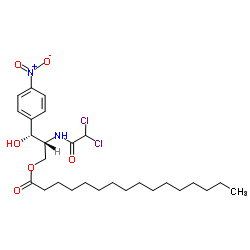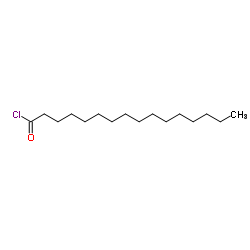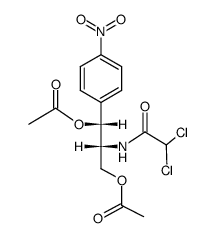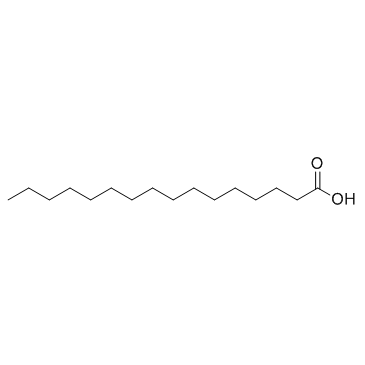530-43-8
| 中文名 | 氯霉素棕榈酸酯 |
|---|---|
| 英文名 | chloramphenicol palmitate |
| 中文别名 |
(2R,3R)-2-[(2,2-二氯乙酰基)氨基]-3-羟基-3-(4-硝基苯基)丙基棕榈酸酯
棕榈酸氯霉素酯 |
| 英文别名 |
Chlorambon
detreopal CHLORAMPHENICOLPALMITATE,BP cap-palmitate Chloramphenicol palmitate Clorolifarina chloromycetinpalmitate Hexadecanoic acid, (2R,3R)-2-[(2,2-dichloroacetyl)amino]-3-hydroxy-3-(4-nitrophenyl)propyl ester CHLORAMPHENICAL PALMITATE (2R,3R)-2-[(dichloroacetyl)amino]-3-hydroxy-3-(4-nitrophenyl)propyl hexadecanoate D-threo-(-)-2,2-Dichloro-N-(β-hydroxy-α-(hydroxymethyl)-p-nitrophenethyl)acetamide α-palmitate EINECS 208-477-9 MFCD00083597 CAP-P Chloramphenicol palmitate (ester) chloramphenicol 3'-palmitate (2R,3R)-2-[(Dichloroacetyl)amino]-3-hydroxy-3-(4-nitrophenyl)propyl palmitate [R-(R*,R*)]-Hexadecanoic Acid 2-[(Dichloroacetyl)amino]-3-hydroxy-3-(4-nitrophenyl)propyl Ester Chloropal D-threo-(-)-2,2-Dichloro-N-(b-hydroxy-a-(hydroxymethyl)-p-nitrophenethyl)acetamide a-Palmitate chlorophenicol palmitate |
| 描述 | Chloramphenicol palmitate 是一种具有口服活性广谱抗生素 (antibiotic),对革兰氏阳性菌和革兰氏阴性菌有广泛的活性。Chloramphenicol palmitate 通过阻断肽基转移酶的合成来抑制细菌的蛋白质合成。Chloramphenicol palmitate 可作为含有氯霉素耐药基因的转化细胞的细菌筛选试剂 (bacterial selection agent)。 |
|---|---|
| 相关类别 | |
| 参考文献 |
| 密度 | 1.2±0.1 g/cm3 |
|---|---|
| 沸点 | 691.6±55.0 °C at 760 mmHg |
| 熔点 | 90ºC |
| 分子式 | C27H42Cl2N2O6 |
| 分子量 | 561.538 |
| 闪点 | 372.1±31.5 °C |
| 精确质量 | 560.242004 |
| PSA | 121.45000 |
| LogP | 9.04 |
| 外观性状 | 晶体,溶于水 |
| 蒸汽压 | 0.0±2.3 mmHg at 25°C |
| 折射率 | 1.526 |
| 储存条件 | 库房低温通风干燥 |
|
Section 1. Chemical Product and Company Identification Chloramphenicol palmitate Common Name/ Trade Name Chloramphenicol palmitate Section 4. First Aid Measures Check for and remove any contact lenses. In case of contact, immediately flush eyes with plenty of water for at least
Eye Contact 15 minutes. Cold water may be used. WARM water MUST be used. Get medical attention. In case of contact, immediately flush skin with plenty of water. Cover the irritated skin with an emollient. Remove Skin Contact contaminated clothing and shoes. Wash clothing before reuse. Thoroughly clean shoes before reuse. Get medical attention. Serious Skin ContactWash with a disinfectant soap and cover the contaminated skin with an anti-bacterial cream. Seek medical attention. InhalationIf inhaled, remove to fresh air. If not breathing, give artificial respiration. If breathing is difficult, give oxygen. Get medical attention. Serious InhalationNot available. Do NOT induce vomiting unless directed to do so by medical personnel. Never give anything by mouth to an Ingestion unconscious person. Loosen tight clothing such as a collar, tie, belt or waistband. Get medical attention if symptoms appear. Serious IngestionNot available. Section 5. Fire and Explosion Data Flammability of the Product May be combustible at high temperature. Auto-Ignition Temperature Not available. Not available. Flash Points Not available. Flammable Limits These products are carbon oxides (CO, CO2), nitrogen oxides (NO, NO2...), halogenated compounds. Products of Combustion Fire Hazards in Presence of Slightly flammable to flammable in presence of heat. Non-flammable in presence of shocks. Various Substances Risks of explosion of the product in presence of mechanical impact: Not available. Explosion Hazards in Slightly explosive in presence of open flames and sparks. Presence of Various Substances SMALL FIRE: Use DRY chemical powder. Fire Fighting Media LARGE FIRE: Use water spray, fog or foam. Do not use water jet. and Instructions Material in powder form, capable of creating a dust explosion. As with most organic solids, fire is possible at elevated Special Remarks on temperatures Fire Hazards Fine dust dispered in air in sufficient concentrations, and in the presences of an ignition source is a potential dust Special Remarks on explosion hazard. Explosion Hazards Section 6. Accidental Release Measures Use appropriate tools to put the spilled solid in a convenient waste disposal container. Finish cleaning by spreading Small Spill water on the contaminated surface and dispose of according to local and regional authority requirements. Use a shovel to put the material into a convenient waste disposal container. Finish cleaning by spreading water on Large Spill the contaminated surface and allow to evacuate through the sanitary system. Chloramphenicol palmitate Section 7. Handling and Storage Keep away from heat. Keep away from sources of ignition. Ground all equipment containing material. Do not Precautions ingest. Do not breathe dust. Wear suitable protective clothing. In case of insufficient ventilation, wear suitable respiratory equipment. If ingested, seek medical advice immediately and show the container or the label. Avoid contact with skin and eyes. Keep container tightly closed. Keep container in a cool, well-ventilated area. Storage Section 8. Exposure Controls/Personal Protection Use process enclosures, local exhaust ventilation, or other engineering controls to keep airborne levels below Engineering Controls recommended exposure limits. If user operations generate dust, fume or mist, use ventilation to keep exposure to airborne contaminants below the exposure limit. Personal ProtectionSplash goggles. Lab coat. Dust respirator. Be sure to use an approved/certified respirator or equivalent. Gloves. Personal Protection in Case Splash goggles. Full suit. Dust respirator. Boots. Gloves. A self contained breathing apparatus should be used to avoid inhalation of the product. Suggested protective clothing might not be sufficient; consult a specialist BEFORE of a Large Spill handling this product. Not available. Exposure Limits Section 9. Physical and Chemical Properties Solid. (Powdered solid.)Not available. Physical state andO dor appearance Bitter. Taste 561.55 g/mole Molecular Weight White. Color Not available. pH (1% soln/water) Not available. Boiling Point 87°C (188.6°F) - 95 C (203 F) Melting Point Not available. Critical Temperature Not available. Specific Gravity Not applicable. Vapor Pressure Not available. Vapor Density Not available. Volatility Not available. Odor Threshold Not available. Water/Oil Dist. Coeff. Not available. Ionicity (in Water) See solubility in water, methanol, diethyl ether. Dispersion Properties Easily soluble in methanol, diethyl ether. Solubility Very slightly soluble in cold water. Freely solubly in ethanol, chloroform, and benzene Chloramphenicol palmitate Section 10. Stability and Reactivity Data The product is stable. Stability Not available. Instability Temperature Conditions of Instability Excessive heat, dust generation. Incompatibility with various Not available. substances Not available. Corrosivity Not available. Special Remarks on Reactivity Not available. Special Remarks on Corrosivity Will not occur. Polymerization Section 11. Toxicological Information Inhalation. Ingestion. Routes of Entry Acute oral toxicity (LD50): 2640 mg/kg [Mouse]. Toxicity to Animals Chronic Effects on Humans May cause damage to the following organs: blood, bone marrow. Other Toxic Effects onSlightly hazardous in case of skin contact (irritant), of ingestion, of inhalation. Humans Not available. Special Remarks on Toxicity to Animals Human: passes through the placenta, excreted in maternal milk. Special Remarks on May cause adverse reproductive effects and birth defects (teratogenic). Chronic Effects on Humans May affect genetic material (mutagenic). May cause cancer. Acute Potential Health Effects: Special Remarks on other Skin: May cause skin irritation. Toxic Effects on Humans Eyes: May cause eye irritation. Inhalation: May cause upper respiratory tract and mucous membrane irritation. Ingestion: May be harmful if swallowed. May cause gastrointestinal tract irritation with hypermotility and diarrhea. It may affect the bone marrow and blood (anemia, clotting, eosinophilia). It may also affect behavior/nervous system(somnolence, ataxia, coma, convulsions,"pins and needles" or numbness in fingers ), metabolism, liver, cardiovascular system, respiration (cyanosis), and urinary system. Chronic Potential Health Effects: Ingestion: Repeated or prolonged ingestion will have similar effects to acute ingestion. Section 12. Ecological Information Not available. Ecotoxicity Not available. BOD5 and COD Products of Biodegradation Possibly hazardous short term degradation products are not likely. However, long term degradation products may arise. The products of degradation are more toxic than the product itself. Toxicity of the Products of Biodegradation Not available. Special Remarks on the Products of Biodegradation Chloramphenicol palmitate Section 13. Disposal Considerations Waste must be disposed of in accordance with federal, state and local environmental control Waste Disposal regulations. Section 14. Transport Information Not a DOT controlled material (United States). DO T Cl assi fi cati on Not applicable. Identification Not applicable. Special Provisions for Transport DO T (Pi ctograms) Section 15. Other Regulatory Information and Pictograms No products were found. Federal and State Regulations California prop. 65: This product contains the following ingredients for which the State of California has found to California cause cancer which would require a warning under the statute: No products were found. Proposition 65 Warnings California prop. 65: This product contains the following ingredients for which the State of California has found to cause birth defects which would require a warning under the statute: No products were found. Other RegulationsOSHA: Hazardous by definition of Hazard Communication Standard (29 CFR 1910.1200). EINECS: This product is on the European Inventory of Existing Commercial Chemical Substances (EINECS No. 208-477-9). Canada: Not listed on Canadian Domestic Substance List (DSL) or Canadian Non-Domestic Substances List (NDSL) China: Not listed on National Inventory. Japan: Not isted on National Inventory (ENCS). Korea: Listed on National Inventory (KECI). Philippines: Listed on National Inventory (PICCS). Australia: Listed on AICS. WHMIS (Canada) Not controlled under WHMIS (Canada). Other Classifications DSCL (EEC)Not availableNot applicable. Health Hazard HMIS (U.S.A.)1 National Fire Protection 1 Flammability 1 Association (U.S.A.) Fire Hazard 1 0 Reactivity Health Reactivity 0 Specific hazard Personal ProtectionE WHMIS (Canada) (Pictograms) DSCL (Europe) (Pictograms) Chloramphenicol palmitate TDG(Canada) (Pictograms) ADR (Europe) (Pictograms) Protective Equipment Gloves. Lab coat. Dust respirator. Be sure to use an approved/certified respirator or equivalent. SECTION 16 - ADDITIONAL INFORMATION N/A |
CHEMICAL IDENTIFICATION
HEALTH HAZARD DATAACUTE TOXICITY DATA
|
| 符号 |

GHS08 |
|---|---|
| 信号词 | Warning |
| 危害声明 | H351 |
| 警示性声明 | P280 |
| 个人防护装备 | dust mask type N95 (US);Eyeshields;Gloves |
| 危害码 (欧洲) | Xn: Harmful; |
| 风险声明 (欧洲) | R40 |
| 安全声明 (欧洲) | 36/37-36-26 |
| 危险品运输编码 | NONH for all modes of transport |
| RTECS号 | RT4735000 |
| 海关编码 | 29414000 |
| 上游产品 9 | |
|---|---|
| 下游产品 2 | |
| 海关编码 | 2924299090 |
|---|---|
| 中文概述 | 2924299090. 其他环酰胺(包括环氨基甲酸酯)(包括其衍生物以及他们的盐). 增值税率:17.0%. 退税率:13.0%. 监管条件:无. 最惠国关税:6.5%. 普通关税:30.0% |
| 申报要素 | 品名, 成分含量, 用途, 包装 |
| Summary | 2924299090. other cyclic amides (including cyclic carbamates) and their derivatives; salts thereof. VAT:17.0%. Tax rebate rate:13.0%. . MFN tariff:6.5%. General tariff:30.0% |










![[R(R*,R*)]-2-(benzylideneamino)-1-(4-nitrophenyl)propane-1,3-diol结构式](https://image.chemsrc.com/caspic/388/55174-65-7.png)

